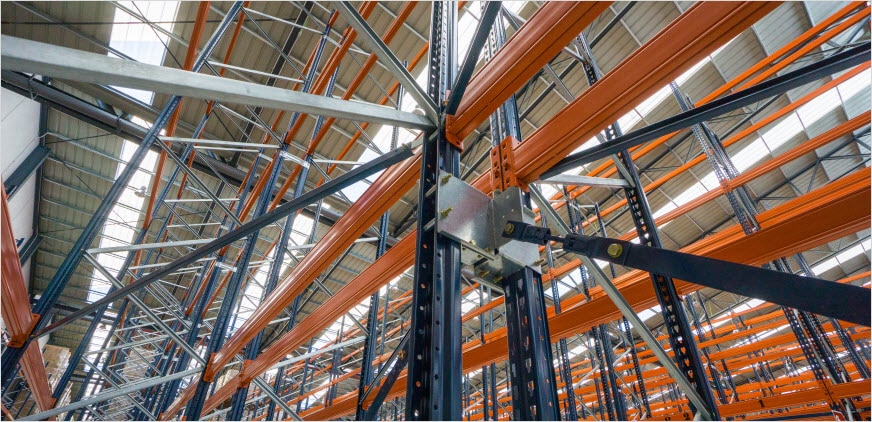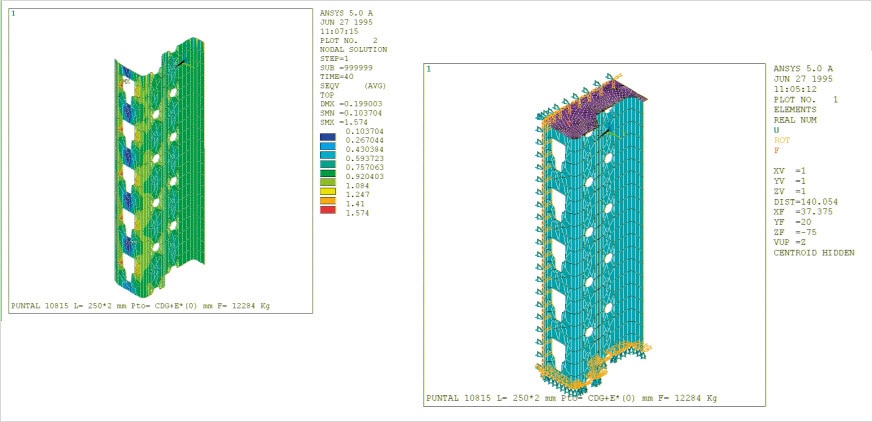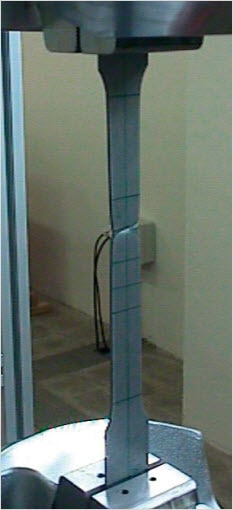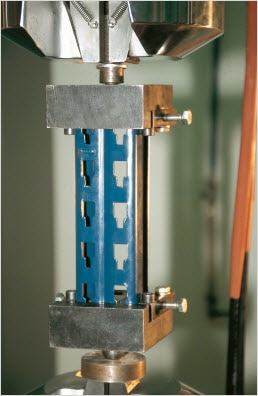Both the components that pallet racks consist of and the materials they are fabricated from are submitted to testing; first to determine their strength and elasticity capacities, whereas the second establishes their tensile strength and their ductility, i.e., the capacity to be bent. These processes fulfil the international standard, which outlines the parameters that must be taken into account with respect to the quality and safety of products.

European standard
Mecalux employs the most advanced techniques in the manufacture of its profiles and racks, taking design principles, testing processes and production control systems into account, which includes the EN 15512 standard, approved in 2009 by the CEN (European Committee for Standardisation).
EN 15512 encompasses all the general European standards regarding the calculation of metal structures and is specifically tailored to adjustable, metal pallet racking.
Ultimately, these standardise calculation procedures, tolerances and the assembly of the racking, as well as facility maintenance.
The fulfilment of the standard by the manufacturer bestows great advantages for the user:
- Safety: the requirements in calculations, trials and testing which materials are submitted to and the inspection of manufacturing and assembly renders better protection for installations, goods and, above all, the personnel working in warehouses.
- Standardisation: fulfilling the internationally recognised standard constitutes a favourable assessment of the installation and the company, especially, in dealings with insurance companies and in the event that liabilities are claimed regarding workplace health and safety.
- Guarantee: products that rigorously fulfil the precepts in terms of safety in all European Union countries garner great confidence in the consumer.

To test or not to test
Predicting the structural behaviour of racking is complicated, due to the particularity of all its components. They are composed of highly resistant steel profiles with a thickness of between 1.8 and 3.0 mm, subject to situations of global, local, as well as distortional buckling, specifically on the uprights. To this end, it is possible to add the behaviour of all the unions between beams and uprights, or between base plates and uprights.
For this reason, modelling in this type of steel structure is distinct to that used for building structures. Racking design is based on specific trials, to obtain the mechanical characteristics of the key components and their connections, to guarantee maximum product quality.
Mecalux possess more than 50 years’ experience in the investigation and design of new solutions to obtain more resistant profiles that satisfy the needs of its customers. A very efficient methodology is applied to the manufacture of new profiles, which consists of four phases:
- Preliminary design of the profiles according to the collective experience and know-how of teams of professionals and engineers.
- Use of design software and calculations of finite elements software like ANSYS, which is capable of determining the behaviours of the distinct parts of the racks. This way the most appropriate model is analysed on a theoretical level and prototypes are constructed from the extracted results.
- Performing tests in its own laboratories, located in Mecalux’s technological centres, which are set up to gather empirical data for the purposes of understanding the behaviour of the different elements and their connections.
- Tests in accredited laboratories, principally thanks to the collaboration with LERMA (*a materials elasticity and resistance laboratory) at the UPC (Universitat Politècnica de Catalunya). These studies certify the results of the tests that have been carried out.
According to the kind of test performed, some of the following results will be obtained:
- Load failure: buckling is a phenomenon in the elastic instability that occurs when the structure is submitted to the action of forces. With this result which loads produce the failure in structural elements is known, and which are permissible taking into account a particular safety factor.
- Stress-strain curve: the full structural body, when withstanding a force, buckles and the stress-strain diagram of the load process allows the relevant magnitudes of the process to be obtained.
- Characteristic value: this refers to the maximum value that, statically speaking, must not be exceeded in order to certify and guarantee the characteristics of the distinct materials and profiles.
It is obtained via two distinct values:
- Correction by material, depending on the actual vs. nominal characteristics of the components.
- Statistical correction, according to the number of tests performed.
Specific element, specific test
The characteristics and behaviours of the materials and elements that comprise the racking have a direct bearing on the safety and durability of structures. As such, each one of the components and its connections are submitted to specific tests, in order to establish quality and guarantee its strength. Several of these tests are described below, in order to better understand the process:
Material testing
It is indispensable to know the physical properties of the materials that are used in engineering projects, and thus it is necessary to carry out specific tests. The racking components are manufactured out of carbon steel. In general, its quality is determined by the EN 1993-1-1 and EN 1993-1-3 standards, even though testing is required to verify its qualities.
Basically, there are two tests:
Tensile testing: verifies the internal force which the profile is placed under in the application of two opposing forces, which tend to stretch it. It is applied with increased traction until breakage takes place.
Bend testing: verifies that the material is able to bend to a required angle. In this way, the form with which you can work and prevent breakage is known by it being submitted to bending without cracking.
Upright testing

Pallet racking uprights are open profiles manufactured from thin cold-formed steel sheet metal. They are perforated all along their length. Specific tests are fundamental to evaluate the global behaviour of the racking elements and connections.
Compression testing: this consists of compressing an axially cut section of an upright, i.e., along it longitudinal axis, to observe how it influences the perforations within localised buckling.
The results of this test allow the determination of:
a. The effective area of the section.
b. The application point of the load maximum, which will serve as a reference in other tests.
This test can be performed on short uprights and on 1,200 mm sections, which correspond to the separation of the diagonal’s frame joints. Moreover, this is the way to verify the influence of distortional buckling.
Testing the bending of uprights: the behaviour of the upright’s bending stress is analysed, i.e., applying a force along the length of it axis.
This study determines the section modulus of an upright section with regards to its long and short axes. This permits the evaluation of the favourable impact of the diagonals that form the frame latticework.
Furthermore, other tests exist for other racking components, such as the upright unions via a splice or the connection of the upright to the floor. The objective is to demonstrate rigidity and strength in light of the load of the racks themselves and the pallets deposited therein.
In the compression of short uprights, the following results can be obtained:
- a) Application of the very displaced force towards the open portion of the section.
- b) Application of the moderately displaced force towards the open portion of the section.
- c) Application of the very displaced force towards the frontal facet (core) of the section.
- d) Application of the moderately displaced force towards the frontal facet (core) of the section.
- e) Application of the force at the point that provides the most profile resistance (maximum load failure).

Tests on frames
Frames are the vertical elements composed of two slotted uprights and are perforated along the length of the profile so that beams fit flush together.
They are set up on the floor via anchored feet (base plates) situated on the inferior ends. The width of the frame will depend on the dimensions of the pallets.
As with individual uprights, the frame compression tests determine the axil section load capacity, taking into account the effect of the diagonals.
In this case, shearing tests are also performed on frames, which consist of applying two parallel and opposing forces to different uprights to verify the behaviour of the shearing strength.
Tests on the beams and beams connectors
Beams are the horizontal and strengthening elements of the racks upon which the loads rest. They require bend tests to analyse buckling when a force is applied from above.
Both ends have connectors and endplates for the proper fastening of frames. These junction elements have been developed and patented by Mecalux. They also need very specific study to evaluate their characteristics and to extrapolate the load maximum that can be exerted upon them and what is the rigidity and strength of its materials.
The shearing test of the beam connectors is intended to demonstrate if the prongs are sufficiently effective to withstand the load. A reverse shearing test is also performed, which demonstrates that the safety pins are effective in the event that the inferior portion of beams suffer a blow. This could occur if the forklift miscalculates the removal of the pallets from the shelves and accidentally bumps the beams.
Mecalux and the Universitat Politècnica de Catalunya
Mecalux has been collaborating with the LERMA laboratory at the UPC for more than 40 years in performing studies on the metal rack’s structural components. This collaboration furnishes Mecalux with a range of perfectly characterised and updated products that are technically cutting edge.
The tests of LERMA are performed to validate that Mecalux profiles fulfil the CEN standards. However, they also carry out investigations for the analysis, design, optimisation and innovation of the components and structural assemblies for storage.
Maximum guarantee and safety
Eleven production plants pertain to Mecalux, which are scattered throughout Europe and North and South America. All the elements that the racks are comprised of are submitted to exhaustive testing and the most stringent quality control measures.
The calculations, testing and design of Mecalux metal racking and warehouses fulfil all the internationally recognised CEN standards, whose requirements with regards to the quality and safety of products culminates in a guarantee of efficacy for customers.
Furthermore, the best guarantee is the thousands of clients worldwide who trust the professionalism, knowledge and excellence of Mecalux to equip their warehouses with the most advance solutions in the market.
